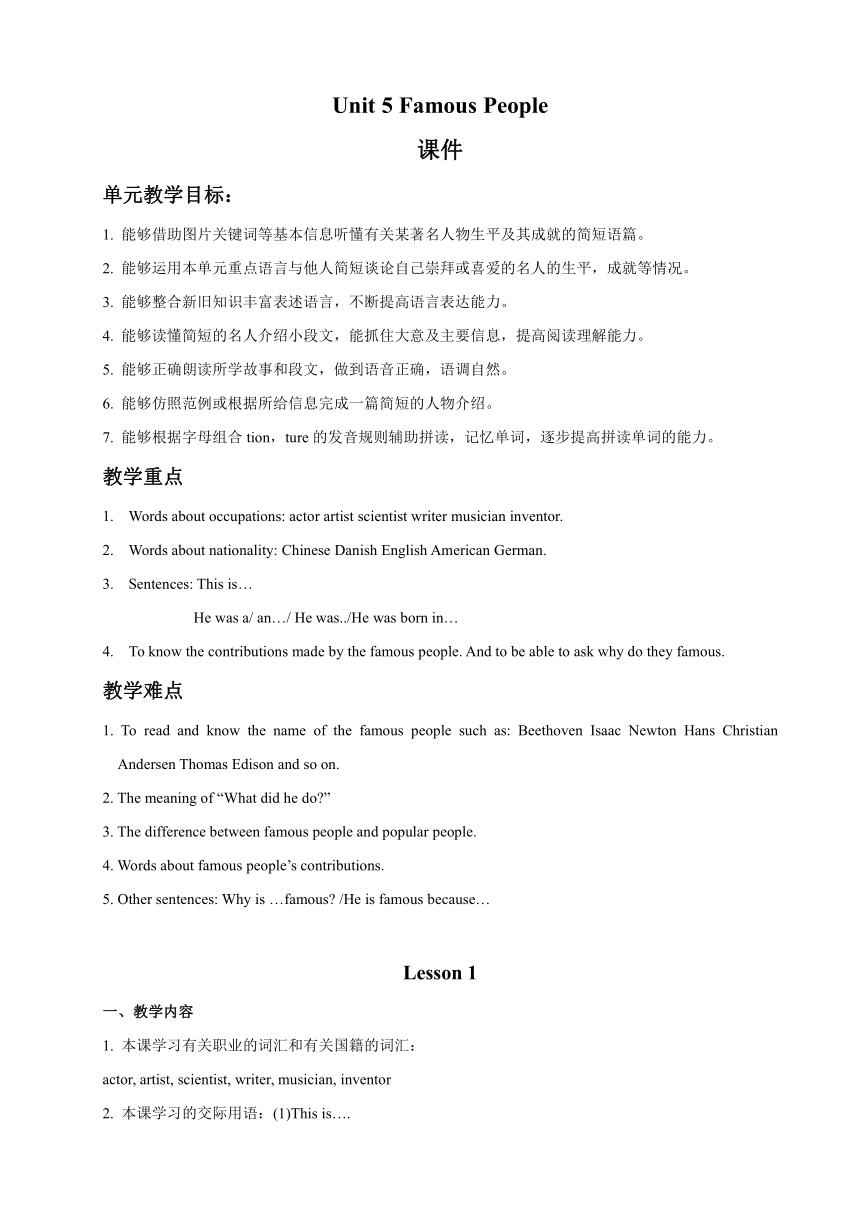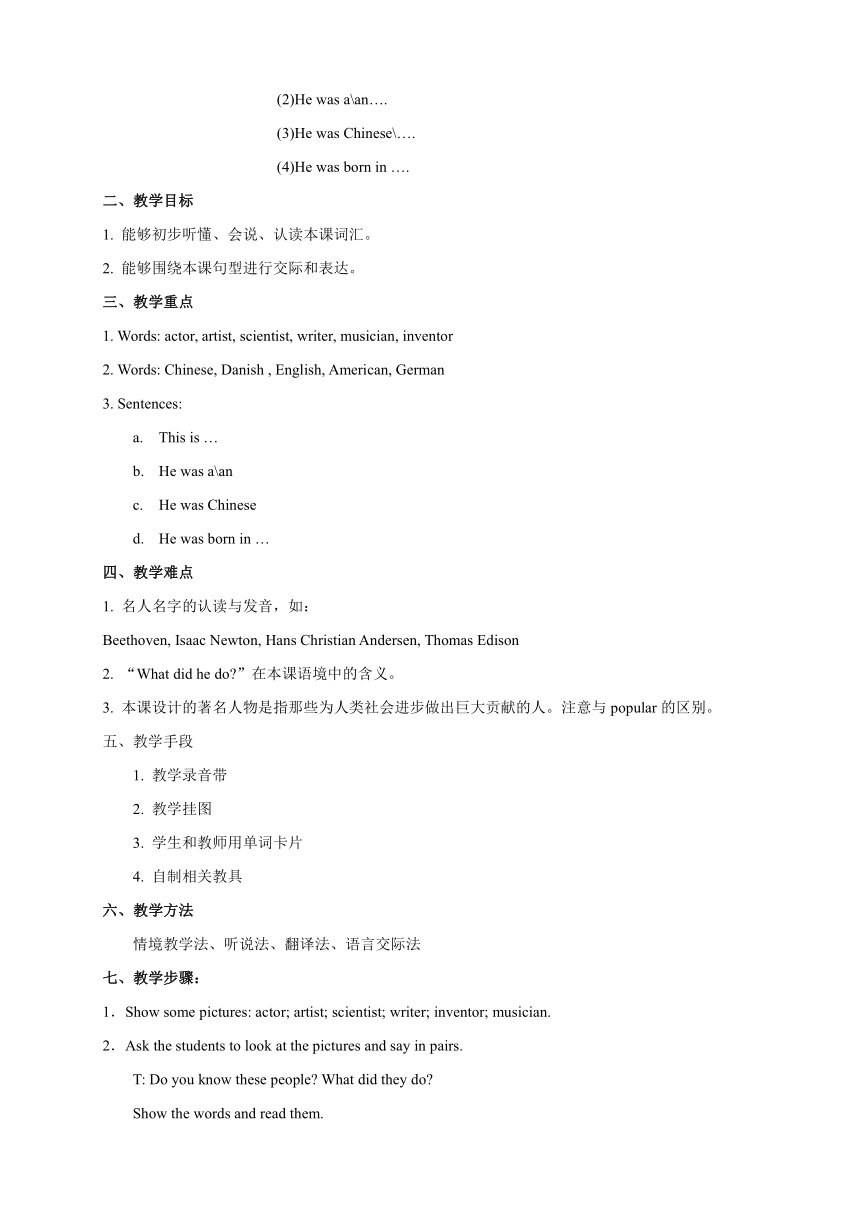Unit 5 Famous People 教案(3个课时)
文档属性
| 名称 | Unit 5 Famous People 教案(3个课时) |

|
|
| 格式 | zip | ||
| 文件大小 | 32.5KB | ||
| 资源类型 | 教案 | ||
| 版本资源 | 人教(新起点) | ||
| 科目 | 英语 | ||
| 更新时间 | 2019-11-14 20:01:19 | ||
图片预览


文档简介
Unit 5 Famous People
课件
单元教学目标:
1. 能够借助图片关键词等基本信息听懂有关某著名人物生平及其成就的简短语篇。
2. 能够运用本单元重点语言与他人简短谈论自己崇拜或喜爱的名人的生平,成就等情况。
3. 能够整合新旧知识丰富表述语言,不断提高语言表达能力。
4. 能够读懂简短的名人介绍小段文,能抓住大意及主要信息,提高阅读理解能力。
5. 能够正确朗读所学故事和段文,做到语音正确,语调自然。
6. 能够仿照范例或根据所给信息完成一篇简短的人物介绍。
7. 能够根据字母组合tion,ture的发音规则辅助拼读,记忆单词,逐步提高拼读单词的能力。
教学重点
Words about occupations: actor artist scientist writer musician inventor.
Words about nationality: Chinese Danish English American German.
Sentences: This is…
He was a/ an…/ He was../He was born in…
4. To know the contributions made by the famous people. And to be able to ask why do they famous.
教学难点
1. To read and know the name of the famous people such as: Beethoven Isaac Newton Hans Christian Andersen Thomas Edison and so on.
2. The meaning of “What did he do?”
3. The difference between famous people and popular people.
4. Words about famous people’s contributions.
5. Other sentences: Why is …famous? /He is famous because…
Lesson 1
一、教学内容
1. 本课学习有关职业的词汇和有关国籍的词汇:
actor, artist, scientist, writer, musician, inventor
2. 本课学习的交际用语:(1)This is….
(2)He was a\an….
(3)He was Chinese\….
(4)He was born in ….
二、教学目标
1. 能够初步听懂、会说、认读本课词汇。
2. 能够围绕本课句型进行交际和表达。
三、教学重点
1. Words: actor, artist, scientist, writer, musician, inventor
2. Words: Chinese, Danish , English, American, German
3. Sentences:
This is …
He was a\an
He was Chinese
He was born in …
四、教学难点
1. 名人名字的认读与发音,如:
Beethoven, Isaac Newton, Hans Christian Andersen, Thomas Edison
2. “What did he do?”在本课语境中的含义。
3. 本课设计的著名人物是指那些为人类社会进步做出巨大贡献的人。注意与popular的区别。
五、教学手段
1. 教学录音带
2. 教学挂图
3. 学生和教师用单词卡片
4. 自制相关教具
六、教学方法
情境教学法、听说法、翻译法、语言交际法
七、教学步骤:
1.Show some pictures: actor; artist; scientist; writer; inventor; musician.
2.Ask the students to look at the pictures and say in pairs.
T: Do you know these people? What did they do?
Show the words and read them.
3.Ask the Ss to listen to the tape twice and number the pictures.
4.Check the answers in pairs.
5.Listen to the tape again and check the answers in class. Then learn the new words.
6.Practice: 1) Read the words.
2) Look at a part of the pictures and say the words.
3) Guessing game with the words.
7.Listen to Part B and repeat it.
8.Make a new dialogue according to part B.
9.Act it in the front of the classroom.
10.Do a survey. (Ask and report)
11.Homework:
Copy the new words.
Write a short passage.
Lesson 2
一、教学内容:
1. 本课学习有关名人成就的词汇。
2. 学习相关的交际用语:Why is ….famous?\ He\She is famous because….
二、教学目标:
1. 能够初步听懂、会说、认读本课词汇。
2. 能够围绕本课句型进行交际和表达。
三、教学重点
1. Words: composed national anthem, sang Peking Opera, painted shrimps, invented the light bulb, wrote stories, man, woman, children
2. Sentence: Why is … famous? He is famous because…
四、教学难点
单词的发音。
五、教学手段
1. 教学录音磁带;
2. 教学挂图;
3. 学生和教师用单词卡片;
4. 教师自制相关教具(如:自制课件、小奖品等)。
六、教学方法
情境教学法、听说法、翻译法、语言交际法
七、教学步骤:
1. Show some pictures: composed national anthem; sang Peking operas, painted shrimps; invented the light bulb; wrote stories.
Ask the Ss to look at the pictures, say them in pairs. (Who is he\she? When was he\she born? What did he she do?)
The teacher show the words; composed national anthem; composed music; sang Peking operas...
2. Ask the Ss to listen to the tape 2 times and match.
3. Ask the Ss try to check the answers in pairs.
4. Ask the Ss to listen to the tape for the third time, and check the answers in class. Meanwhile, learn the new words.
5. Practice: 1) Read the words.
2) Look at a part of the pictures and say the words.
3) Play games.
6. Listen to part (B) and repeat it.
7. Make a new dialogue according to part (B).
8. Act the dialogue.
9. Do a survey. (Ask and report)
10. Homework
1) Copy the new words.
2) Write a short passage.
Lesson 3
一、教学内容
1.本课围绕名人及其相关信息进行读写交流活动。
2.综合运用前两课时所学内容,以小语片的形式介绍以为名人的简单情况。
二、教学目标
1. 能够正确理解文段。
2. 能够围绕本单元主要交际句型进行交际和表达。
三、教学重点和难点
1. 综合运用所学语言。
2. 完成简短的人物介绍。
四、教学手段
1. 教学录音磁带;
2. 教师自制课件;
3. 学生和教师用单词卡片。
五、教学方法
情境教学法、听说法、翻译法、语言交际法
六、教学步骤:
1. 1)Read the words.
2) Read the words and match them.
3) Guessing game.
2. Show the pictures of part A, let the Ss discuss them. (name, born why; famous)
3. Read part A, underline the direction of the places, and fill in the chart.
4. Check the answers, listen to the tape and read it.
5. Play the guessing game with the cards in the group.
6. Group work: Everyone choose one place, and try to say.
7. Choose some groups to show.
8. The teacher gives the clues to ask the Ss to write some sentences about one famous place.
9. Homework:
1) Recite the words.
2) Finish the passage.
PAGE
课件
单元教学目标:
1. 能够借助图片关键词等基本信息听懂有关某著名人物生平及其成就的简短语篇。
2. 能够运用本单元重点语言与他人简短谈论自己崇拜或喜爱的名人的生平,成就等情况。
3. 能够整合新旧知识丰富表述语言,不断提高语言表达能力。
4. 能够读懂简短的名人介绍小段文,能抓住大意及主要信息,提高阅读理解能力。
5. 能够正确朗读所学故事和段文,做到语音正确,语调自然。
6. 能够仿照范例或根据所给信息完成一篇简短的人物介绍。
7. 能够根据字母组合tion,ture的发音规则辅助拼读,记忆单词,逐步提高拼读单词的能力。
教学重点
Words about occupations: actor artist scientist writer musician inventor.
Words about nationality: Chinese Danish English American German.
Sentences: This is…
He was a/ an…/ He was../He was born in…
4. To know the contributions made by the famous people. And to be able to ask why do they famous.
教学难点
1. To read and know the name of the famous people such as: Beethoven Isaac Newton Hans Christian Andersen Thomas Edison and so on.
2. The meaning of “What did he do?”
3. The difference between famous people and popular people.
4. Words about famous people’s contributions.
5. Other sentences: Why is …famous? /He is famous because…
Lesson 1
一、教学内容
1. 本课学习有关职业的词汇和有关国籍的词汇:
actor, artist, scientist, writer, musician, inventor
2. 本课学习的交际用语:(1)This is….
(2)He was a\an….
(3)He was Chinese\….
(4)He was born in ….
二、教学目标
1. 能够初步听懂、会说、认读本课词汇。
2. 能够围绕本课句型进行交际和表达。
三、教学重点
1. Words: actor, artist, scientist, writer, musician, inventor
2. Words: Chinese, Danish , English, American, German
3. Sentences:
This is …
He was a\an
He was Chinese
He was born in …
四、教学难点
1. 名人名字的认读与发音,如:
Beethoven, Isaac Newton, Hans Christian Andersen, Thomas Edison
2. “What did he do?”在本课语境中的含义。
3. 本课设计的著名人物是指那些为人类社会进步做出巨大贡献的人。注意与popular的区别。
五、教学手段
1. 教学录音带
2. 教学挂图
3. 学生和教师用单词卡片
4. 自制相关教具
六、教学方法
情境教学法、听说法、翻译法、语言交际法
七、教学步骤:
1.Show some pictures: actor; artist; scientist; writer; inventor; musician.
2.Ask the students to look at the pictures and say in pairs.
T: Do you know these people? What did they do?
Show the words and read them.
3.Ask the Ss to listen to the tape twice and number the pictures.
4.Check the answers in pairs.
5.Listen to the tape again and check the answers in class. Then learn the new words.
6.Practice: 1) Read the words.
2) Look at a part of the pictures and say the words.
3) Guessing game with the words.
7.Listen to Part B and repeat it.
8.Make a new dialogue according to part B.
9.Act it in the front of the classroom.
10.Do a survey. (Ask and report)
11.Homework:
Copy the new words.
Write a short passage.
Lesson 2
一、教学内容:
1. 本课学习有关名人成就的词汇。
2. 学习相关的交际用语:Why is ….famous?\ He\She is famous because….
二、教学目标:
1. 能够初步听懂、会说、认读本课词汇。
2. 能够围绕本课句型进行交际和表达。
三、教学重点
1. Words: composed national anthem, sang Peking Opera, painted shrimps, invented the light bulb, wrote stories, man, woman, children
2. Sentence: Why is … famous? He is famous because…
四、教学难点
单词的发音。
五、教学手段
1. 教学录音磁带;
2. 教学挂图;
3. 学生和教师用单词卡片;
4. 教师自制相关教具(如:自制课件、小奖品等)。
六、教学方法
情境教学法、听说法、翻译法、语言交际法
七、教学步骤:
1. Show some pictures: composed national anthem; sang Peking operas, painted shrimps; invented the light bulb; wrote stories.
Ask the Ss to look at the pictures, say them in pairs. (Who is he\she? When was he\she born? What did he she do?)
The teacher show the words; composed national anthem; composed music; sang Peking operas...
2. Ask the Ss to listen to the tape 2 times and match.
3. Ask the Ss try to check the answers in pairs.
4. Ask the Ss to listen to the tape for the third time, and check the answers in class. Meanwhile, learn the new words.
5. Practice: 1) Read the words.
2) Look at a part of the pictures and say the words.
3) Play games.
6. Listen to part (B) and repeat it.
7. Make a new dialogue according to part (B).
8. Act the dialogue.
9. Do a survey. (Ask and report)
10. Homework
1) Copy the new words.
2) Write a short passage.
Lesson 3
一、教学内容
1.本课围绕名人及其相关信息进行读写交流活动。
2.综合运用前两课时所学内容,以小语片的形式介绍以为名人的简单情况。
二、教学目标
1. 能够正确理解文段。
2. 能够围绕本单元主要交际句型进行交际和表达。
三、教学重点和难点
1. 综合运用所学语言。
2. 完成简短的人物介绍。
四、教学手段
1. 教学录音磁带;
2. 教师自制课件;
3. 学生和教师用单词卡片。
五、教学方法
情境教学法、听说法、翻译法、语言交际法
六、教学步骤:
1. 1)Read the words.
2) Read the words and match them.
3) Guessing game.
2. Show the pictures of part A, let the Ss discuss them. (name, born why; famous)
3. Read part A, underline the direction of the places, and fill in the chart.
4. Check the answers, listen to the tape and read it.
5. Play the guessing game with the cards in the group.
6. Group work: Everyone choose one place, and try to say.
7. Choose some groups to show.
8. The teacher gives the clues to ask the Ss to write some sentences about one famous place.
9. Homework:
1) Recite the words.
2) Finish the passage.
PAGE
同课章节目录
- Unit 1 In China
- Lesson 1
- Lesson 2
- Lesson 3
- Unit 2 Around the World
- Lesson 1
- Lesson 2
- Lesson 3
- Unit 3 Animal World
- Lesson 1
- Lesson 2
- Lesson 3
- Revision 1
- Unit 4 Feelings
- Lesson 1
- Lesson 2
- Lesson 3
- Unit 5 Famous People
- Lesson 1
- Lesson 2
- Lesson 3
- Unit 6 Winter Vacation
- Lesson 1
- Lesson 2
- Lesson 3
- Revision 2
